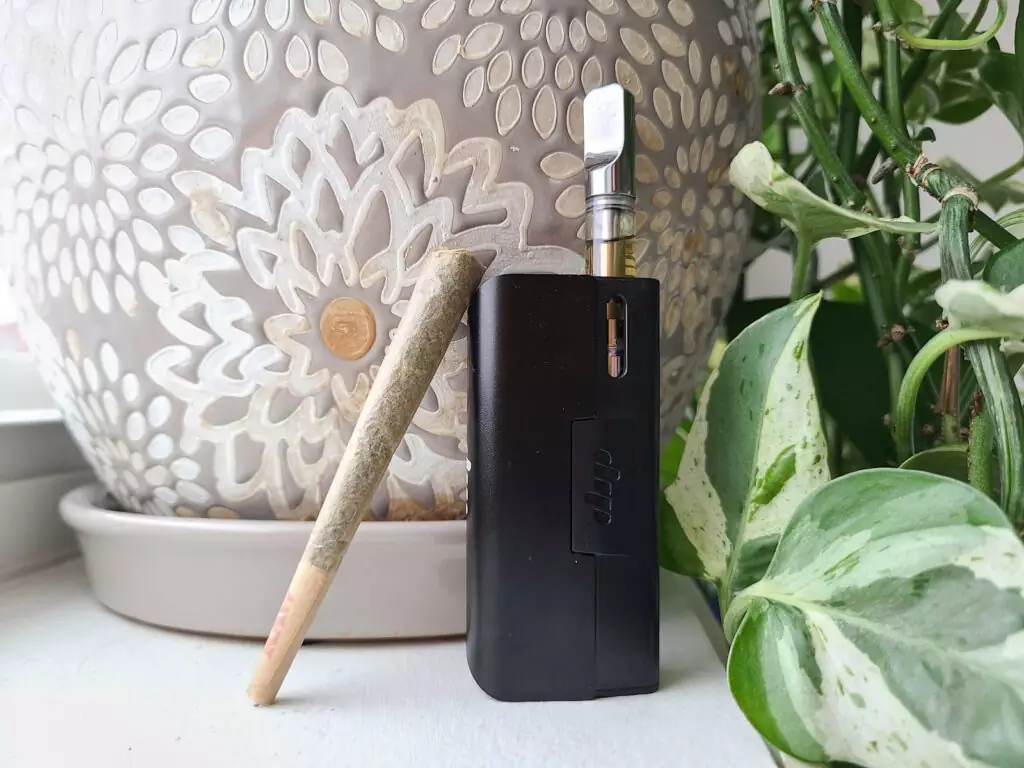To be a leading cannabis, hemp, CBD and Delta-8 THC PR agency, you need to know a thing or two about cannabis and its derivatives. We’ve shared multiple blogs about our knowledge of cannabis, from which conferences you should keep an eye on in 2022 to common misconceptions about working in the realm of cannabis PR. That’s why we want to get into the nitty-gritty of two common methods of consumption as well as address questions you’ve maybe thought of but didn’t know who to ask. As you’re likely aware, there are multiple ways to consume cannabis, including using tinctures, edibles and more. Two of the most popular methods of cannabis consumption are smoking and vaping. What are some similarities? How about differences? Let’s explore.
Regardless of the method, cannabis must be heated to achieve psychoactive effects. This is due to the process of decarboxylation, which activates the compounds within the cannabis plant and releases cannabinoid capabilities. Decarboxylation can happen instantly when cannabis is smoked or vaped. However, there are some interesting differences between the two methods of consumption. Here are your questions, answered.
What’s the deal with smoking?
Smoking has long been hailed as a fantastic way to consume cannabis by experienced cannabis users. As a method, smoking happens when cannabis is burned, releasing desired cannabinoids like THC and CBD, among others. Cannabis and hemp users alike smoke cannabis in a variety of fashions. Some consumers will buy smokable flower and roll it into a cigarette/rolling paper or pack it into a glass or ceramic piece. Others will purchase cannabis or CBD cigarette pre-rolls to test out. In addition to flower, consumers often indulge in hash and kief.
What about vaping?
Vaping is another popular method of inhalation-based cannabis consumption. Vaping is delivered by heating dry flower, extracted cannabis plant liquids, or concentrated oils and consuming via inhalation. Vaping is newer to the scene than its smoking counterpart but has caught much attention for plenty of good reasons. Essentially, vaping works by heating the chosen substance below its combustion point. This method allows users to experience psychoactive effects, but with fewer toxins. Moreover, due to the lower temperature, more terpenes are usually preserved by vaporization. To vaporize cannabis extracts, concentrates are placed onto an atomizer which then heats up and melts the concentrates, which are then inhaled. Popular vaping options involve products such as dry herb vaporizers, electric dab straws, and pod-based vape cartridges.
Let’s Talk Pros and Cons
On Health:
Often, vaping has been considered a safer method of consumption. Some studies have shown vaping to release fewer toxins than smoking, and there isn’t a risk of tar build-up, as it’s not inhaled. Vaping could also mitigate some of the risks associated with smoking, such as reducing the likelihood of damaged skin and reduced exposure to carcinogens. Smoking cannabis can also lead to inflammation, and cause issues such as cough and increased mucus production, as well as irritations to the respiratory system. However, there has been some evidence that vaping has its issues as well. Some consumers have been injured by the use of vaporizers because of e-cigarette or vaping product-use-associated lung injury (EVALI). EVALI has been shown to cause side effects like nausea, cough, chest pain and shortness of breath, with some experiencing severe side effects. Smoking with a filter can curb some of smoking’s negative health effects. Filters reduce the number of harsh toxins, and for those who want to smoke, this can be a helpful option.
Heating Methods:
Of course, there are more than just differences in health effects between smoking and vaping. Another prime example is that vaporizers are electronic. Unlike traditional smoking methods, vaporizers rely on electrical power to operate, meaning that they must be charged to be used. This could cause problems if you’re on the go and nowhere near an outlet. Smoking, which has been around before electricity, requires nothing but some paper or a glass piece and open flame. Both of these sources of heat come with their own set of risks. Open flames can cause problems in indoor settings, just as electrical outlets can short circuit.
What about cost?
Smoking and vaping have both been said to be cost-effective; however, this depends substantially on what you’re addressing. For instance, vaporizing flower can turn out to save money in the long run. This is because you actually use less of the plant vaping flower than you do smoking it. This in turn can save you money, and the flower at the end of the session can be repurposed and used for things like edibles. Vaporizers can carry a large upfront cost, however, as the technology is rather expensive, particularly if you’re looking to grab a long-lasting piece of equipment. On the other hand, vaporizing other materials like extracts and oils can often become expensive depending on your frequency of use. In addition to buying a vaporizer, you’ll need to purchase extracts or oils, which can cost significantly more than flower.
Taste Preference
The differences in vaping and smoking can also often boil down to preference in taste. Some vape users swear on the fact that vaping can enhance the flavor of terpenes, especially in flower, as terpenes are often kept intact and well-preserved. Furthermore, some people enjoy vaporizing their products because the scent isn’t as strong and doesn’t “stick around” as cannabis smoke often can. Nevertheless, some prefer the strong taste of cannabis smoke as well as the ritualistic experience that comes with rolling paper or smoking out of a bowl.
Are the effects different?
There may be evidence to suggest that vaping could produce more pronounced effects than smoking. After consuming the same dose of THC through vaporizing, users were noticeably more impaired. Essentially, vaping made users feel the high more prominently, which could be positive or negative depending on who’s looking to partake. Furthermore, vaporizing flower or concentrates may have a direct effect on the experience. When cannabis undergoes the process of extraction, beneficial terpenes may be stripped away. Terpenes have a massive influence on the effects of cannabis, so cutting terpenes could change the experience. Similarly, smoking cannabis can also have an impact on the amount of terpenes ingested, as smoking can burn terpenes away.
Is pollution an issue?
Whether you’re vaporizing or smoking, both come with a risk of post-consumer pollution. Smoking papers must be discarded after use, and some pre-rolls come in non-recyclable packaging. In terms of vaping, some argue that vaporizing can reduce pollution. However, this assumes that reusable vaporizing methods are being used. Some vaporizers are disposable, but recycling is often hard to find even for programs that do exist. There are ways to make smoking and vaporizing more environmentally friendly! Using glass to smoke or use concentrates can ensure that no materials must be wasted after use. Seek out brands that use sustainable packaging. Furthermore, if you vape, you can choose to use a reusable vaporizer or vape pen rather than a disposable model.
In addition to product pollution, there are also chances of introducing pollutants to your body. Cannabis flower is often sprayed with multiple pesticides to reduce potential harms like powdery mildew, spider mites, heavy metals and more. Cannabis flower and concentrates are held to rigorous standards to pass inspection, but sometimes large amounts of pesticides can still exist in the plant after purchase. Some methods of extraction can strip pesticides, but it often comes down to the amount of regulation to ensure you’re not introducing potential toxins to the body, whether you choose to partake in vaporizing or smoking. In any case, be sure to opt for products that are lab tested and traced to be certain that your product is as clean as it can be.
More studies must be done to fully encapsulate the effects, but to be sure that you’re being as safe as possible, always be sure to buy products you trust and stay away from potentially adulterated products. There will be risks that come with both smoking and vaping as cannabis consumption methods, but each come with their benefits as well. We hope this could help explain some of the nuances between smoking and vaping, but continuing to search and gain knowledge will enable you to make informed choices for how best to partake.
Looking for help from our experienced psychedelics and cannabis PR, SEO and marketing team? Let us know if you need help researching trends and topics, crafting communications, or securing news spots by contacting NisonCo here.



